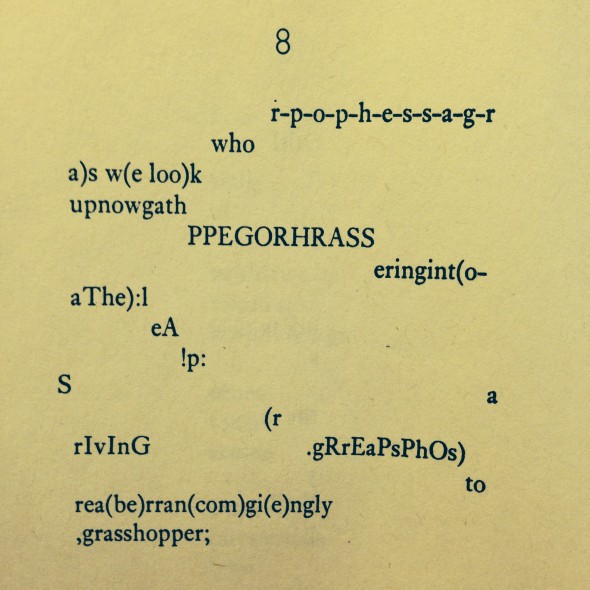by Debbie Vance
We all know E.E. Cummings as that lyrical, satirical, modernist poet with odd line breaks, lowercase letters, bizarre punctuation. But he was also a Cubist painter, and it is believed that his background in this disjointed art form is what led him to his unique poetic style.
The exposure to Cubism encouraged him to become a Cubist painter and also stimulated him to develop a poetic style in which he wrenched language into new meanings by way of fragmented statements, harsh juxtapositions, grammatical distortions, and starling images. “The Symbol of all Art is the Prism,” he declared. “The goal is unrealism. The method is destructive. To break up the white light of objective realism into the secret glories which it contains.” (from the Introduction to Cummings’ Selected Poems by Richard S. Kennedy)
Case in point: Below you’ll find one of his oil paintings, “Sound,” and his poem, “r-p-o-p-h-e-s-s-a-g-r,” which is meant to imitate a grasshopper gathering itself for the leap.

Sound, oil painting by E.E. Cummings
And here-to prove his myriad styles-is one of his love poems,”i like my body when it is with your body,” which, given that he leaves them all untitled, goes by it’s first line (or so):
i like my body when it is with your
body. It is so quite a new thing.
Muscles better and nerves more.
i like your body. i like what it does,
i like its hows. i like to feel the spine
of your body and its bones,and the trembling
-firm-smooth ness and which i will
again and again and again
kiss, i like kissing this and that of you,
i like,slowly stroking the,shocking fuzz
of your electric fur,and what-is-it comes
over parting fles….And eyes big love-crumbs,and possibly i like the thrill
of under me you so quite new
BUT—of even more interest (and perhaps lesser known than his Cubist leanings)-he is also author to a book of children’s fairy tales. The collection of four stories was published posthumously, and the original preface, written by Cumming’s widow, Marion Morehouse Cummings, said, “These tales were written for Cumming’s daughter Nancy, when she was a very little girl.” (Although it is believed that one tale, “The Elephant & The Butterfly,” was written much later, and for his grandson.) They are sweet stories, simply told, of “lonely and extraordinary characters finding friendship in unlikely companions.” Definitely a surprise twist in Cummings’ extensive, modernist, poetic career. And a welcome one. Below is the opening paragraph to the story, “The Old Man Who Said ‘Why,’” followed by images from within the tale.
Once there was a faerie who lived on a farthest star. He was good-natured and had yellow hair and blue eyes. Everybody in the air and everywhere and in all the stars respected him, and took all their troubles to him whenever something went wrong. For millions of years he lived quietly and happily without growing any older (because he was a faerie and faeries never grow any older) and he was very polite and he had a wonderful smile and a pair of golden wings.

From “The Old Man Who Said ‘Why,’” illustrated by Meilo So
Tags: cubism, EE Cummings, fairy tales, poetry









[…] by E.E. Cummings, illustrated by Meilo So. (See Conundrum Press’ post on this book: “Fairy Tales from a Cubist Poet.”) This collection of four tales offers a unique glimpse into the well-known (and loved) […]